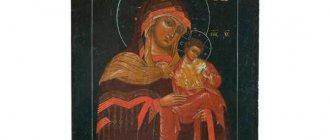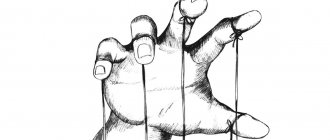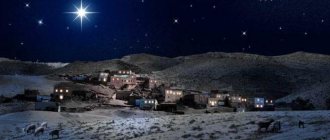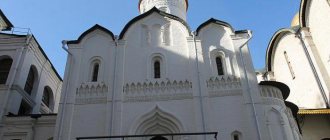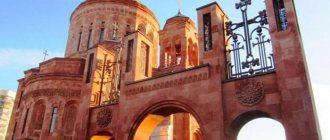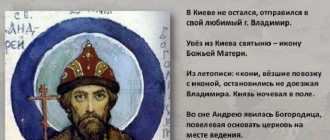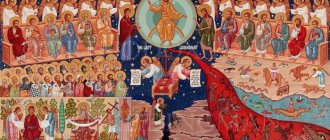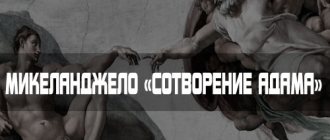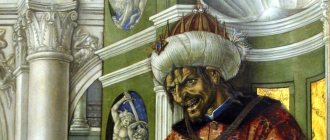Article on the topic
Eternal plot.
The Publican and the Pharisee in works of art The Gospel parable of the Last Judgment has always worried people of art: artists painted scenes of the apocalypse in paintings, poets wrote about the punishment of sinners and the salvation of the righteous in their poems, and film directors depicted the end of the world in films. True, some treated the biblical story with humor - for example, Joseph Brodsky in “Asian Maxims” wrote: “The Last Judgment is the Last Judgment, but in general, a person who lived his life in Russia should be placed in heaven without any further discussion.”
AiF.ru invites you to recall the most impressive works of art in which the theme of the end of times sounds.
A brief history of the creation of the altar image
In 1534, the brilliant creator received an order from Pope Clement VII to paint the huge wall of the Sistine Chapel, which was 13.7 m long and 12 m high. He did not start work, but when Clement VII died, his successor Paul III called in 1537 Michelangelo to Rome. Work did not begin until the slope of the wall was changed and the artist received ultramarine, which was more expensive than gold. At this time he was no longer young, he was 62 years old. Enormous work on scaffolding on wet plaster required colossal not only moral, but also physical effort, with which, having created the Last Judgment, Michelangelo plunged his contemporaries into awe on October 31, 1537.
Opening ceremony of the fresco
The highest clergy, led by Pontiff Paul III (Farnese), and the invited laity were shocked by the cosmogonic spectacle they saw. Michelangelo's "Last Judgment" had no analogues. The shock was so great and the tension so strong that Paul III fell to his knees, begging God not to remember his sins on the Day of Judgment.
Contemporaries perceived the fresco with fear and admiration, amazed at the skill and strength of Michelangelo and the grandiose picture of the end of times. This should be emphasized, because the second coming of Christ is a universal catastrophe, in which the earth will regain its original state. Humanity, as a historically existing one, is moving into a new quality from temporary and mortal life to eternal life. Some will find salvation and eternal life in heaven, while others will end up in hell for their sins.
The plot in the paintings of artists
The Last Judgment was depicted not only in ancient times on various icons and temples, at the same time, various artists of various times depicted this vivid theme in their own canvases, therefore, it at one time found a place in modern painting.
The famous Michelangelo has a special fresco that is made on this theme, it is located on the Sistine Chapel.
There is also a picture that has an incredible effect on the person who sees it. It was made by the famous Hieronymus Bosch. In his work, the plot of Judgment Day is divided into three parts, in the central part the immediate judgment is depicted, at the head of which is Jesus Christ, on the left side is paradise, at the gate of which stands the Mother of God, and to the right of the Central image is the entrance, which is guarded by Satan. A person who has seen this picture at least once in his life can note that the composition is especially realistic.
In addition to the masters presented above, many artists used various biblical scenes of the Last Judgment in their works. Some depicted only parts of it, while others tried to bring to life the entire composition of this image; as a result of such actions, a large number of different options arose, which, unfortunately, are not very close to the Orthodox Church canons.
Vatican. The Sistine Chapel
Michelangelo's Last Judgment fits into the entire program of the Sistine Chapel. On the vault - the creation of the world and man and his fall, the beginning of civilization, on the walls - Moses and Christ as life under the laws, life under grace, and, finally, on the end altar wall the Last Judgment is depicted.
This was exceptional for the iconography of the time because the Last Judgment was depicted on the western wall. When leaving the church, the believer saw a warning about what awaits him at the end of time. The placement of the Last Judgment on the altar further enhances its significance. Now we begin to examine Michelangelo's fresco "The Last Judgment". The description begins.
Punishing and merciful God
In the center of the composition is Christ-Helios, that is, Christ as light, like Apollo. This is originally an early Christian idea. Around him are the saints and martyrs who are in heaven. Closest to him: Mary, St. Peter, St. John the Baptist, St. Lawrence and St. Bartholomew. Christ is in heaven in a completely unusual form without a beard, as a giver of light and surrounded by this light. This is a completely new image of the Savior.
His pose simultaneously expresses mercy and anger. Because with one hand he blesses. It is directed to the left towards the righteous. The other, pointing to the right side, is towards sinners, he punishes. The figure of the Savior is imbued with power and unearthly beauty. We must remember that Michelangelo was a Neoplatonist. Therefore, his body, mind and soul were one. The gesture of the right raised hand pacifies the excitement and allows the slow rotational movement of all the characters in the fresco to begin.
Michelangelo “The Last Judgment”: description of the painting
Compositionally, the picture is divided into several parts. In the center is the figure of Jesus Christ. His hand is raised in a punishing gesture, his menacing face is turned towards the sinners. Next to Christ is the Virgin Mary, she turned away in confusion. Madonna cannot interfere in the court, but she is also not able to reject selfless love for all humanity.
The central figures are surrounded by two rows of bodies. In the first, the neighbor, the prophets and apostles are located. The second circle is formed by the bodies of sinners falling and dragged by demons into the abyss of hell, and the ascending righteous.
At the bottom of the fresco are seven angels proclaiming the coming of the Last Day. Graves open under them, the dead again receive bodies, Charon drives sinners from his boat into the abysses of hell with an oar.
Self-portrait
The most amazing thing in the fresco is the image of Bartholomew sitting at the feet of Christ. He holds his skin, flayed from him by the pagans. This is how Michelangelo depicts his self-portrait.
That is, he makes himself involved in the end of times, becomes a participant in this universal cataclysm. In this way he prays to God for forgiveness, appearing before him in a strange appearance. This is what the central part of Michelangelo's Last Judgment fresco looks like.
Liturgical significance in pre-revolutionary Russia
One of the most valuable sources about the Russian Orthodox Church, “Officials of the Assumption Cathedral,” describes in detail the special service associated with this icon. It was called “The Last Judgment Act.” During its celebration, the icon of the same name was brought out for veneration to the patriarch and the king. This Orthodox rite was held on the Sunday before Maslenitsa on the cathedral square in the Kremlin. First, according to the rules, stichera were performed, why the waters were blessed and the Gospels were read. At the final stage, the patriarch wiped the image of the “Last Judgment” with a sponge. Then he sprinkled holy water on the sovereign and ordinary people.
Taking the righteous to heaven
The resurrection of the dead and the acquisition of bodies is decided in an unusual way. There is nothing like it in the history of art. The righteous, having lost their material heaviness, overcome gravity and slowly soar upward.
Saints and martyrs help them, supporting them along this path. There are even rosary beads that they grab onto: that is, we will be saved only through prayer and asceticism. This image invites you to think about how scary it is to appear in court and not give an account of the rights and wrongs of your deeds. The inexorable, dispassionate wheel of samsara appears before us, when a person will receive what he deserves only for earthly deeds. This is how Michelangelo Buonarroti saw the Last Judgment.
What influenced the plot
Scientists, historians and other experts claim that the plot for this Holy Face called the Last Judgment was taken from the following ancient documents and books that connect not only Byzantium, but also Kievan Rus. Therefore, the plot was:
- Gospels;
- Apocalypse;
- palladium word Mniha;
- life of Vasily Novy;
- the word of Sirin;
- The revelation of John the Evangelist had an important influence on the creation of the plot.
At the same time, a clear source for creating the plot in the image was the revelation of a certain prophet Daniel. Since his prophecy is still important for Orthodox Christian believers, it is described in the writings of the Prophet. A certain number of prayers and moliebens for creation were taken specifically from the book of the prophet Daniel. These prayers spoke not only about the end of the world, but also about the second appearance of Jesus Christ.
Initial version
It should be borne in mind that Michelangelo originally depicted all the saints, Christ and the Virgin Mary, naked. He proceeded from the text of St. Paul that when everyone is resurrected, they will find new heavenly bodies destined for eternal life.
Therefore, for Michelangelo, the specific person, the specific martyr or saint whom he portrays was not important. All of humanity came together at this moment of the end of time. Humanity is united in its nakedness. This has nothing to do with the concept of earthly nudity, but on the contrary, nudity aligns everyone in the face of God. We are different only in clothes, and when they are not there, then we are all equal. This idea was important to Michelangelo.
Pope Paul IV demanded that all the characters, more than four hundred of them, be “dressed.” The work was carried out by Daniele da Volterra.
The emergence of the plot and the first images
There are many different legends associated with the origins of this Holy image and the scenes depicted on it. Some people believe that this Holy image originally appeared on the wall of some Byzantine cathedral, before the onset of the iconoclastic stage. From such information, historians conclude that this icon can be dated to the 4th century. The primary subjects that were depicted often told the legend of the righteous, the sinners and the ten virgins. Around the eighth century, the final version of the Holy Image was installed in the Byzantine Empire, which was canonized. This is exactly how the Holy Face appeared before modern Orthodox Christian believers.
Dive into Hell
Below, angels trumpet the beginning of the Last Judgment. They are holding two books.
The little book of life, which is directed towards the righteous, and the large book of death, which looks towards the sinners. There are many more of them: many are called, but few are called. And on the one hand we see sinners being thrown down, a cycle goes on, then the resurrected righteous people slowly rise up. The entire composition is given an epic pathos.
For sinners, Michelangelo’s “Last Judgment” (we continue to present the description of the painting to your attention) is truly terrible. They are dragged by the devils to the boat of Charon, who will transport them forever to Hell. Malicious faces look out from it, which will cause people torment as punishment for their sins. Michelangelo's "Last Judgment" is an eternal reminder that one must live according to the Ten Commandments, which Christ proclaimed when he descended from Mount Tabor.
Ivan Turgenev's Dream "The End of the World" (1878)
Despite the fact that the author defined the genre of his creation as a dream and described everything with his inherent realism, “without embellishment,” reading the work is still a little creepy:
Article on the topic
Oryol nobleman. How Turgenev brought Russian literature to world leadership
“Look! look! the ground has collapsed!
- How? failed?!
Exactly: before there was a plain in front of the house, but now it stands on the top of a terrible mountain! The sky fell, went down, and from the house itself an almost vertical, as if dug up, black steep slope descends.
We all crowded at the windows... Horror freezes our hearts.
- Here it is... here it is! - my neighbor whispers.
And then along the entire distant edge of the earth something began to move, some small round tubercles began to rise and fall.
"This is the Sea! - we all thought at the same moment. “It’s about to flood us all... But how can it grow and rise up?” Up this steep slope?
And yet, it grows, grows enormously... These are no longer individual tubercles rushing in the distance... One continuous monstrous wave embraces the entire circle of the sky.
She's flying, flying towards us! It rushes like a frosty whirlwind, spinning in pitch darkness. Everything around began to tremble - and there, in this rushing mass, there was a crash, and thunder, and a thousand-throated, iron bark...
Ha! What a roar and howl! The earth howled in fear...
The end of it! The end of everything!
The boy squeaked again... I wanted to grab onto my comrades, but we were all already crushed, buried, drowned, carried away by that ink-black, icy, roaring wave!
Darkness... eternal darkness!
Barely catching my breath, I woke up.”
An excerpt from Ivan Turgenev’s work “The End of the World”
One of many
Just look at the figure of a sinner covering his sorrowful face with his hand. An expression of fear and hopelessness is written on his face: the melancholy and despair is shown by the mask frozen on his face. The devils grabbed him tightly by the legs and, smiling joyfully, dragged him along. His powerful, athletic body makes no attempt to free himself. Only now did he realize that the Last Judgment had entered his sinful existence. Michelangelo captures the inevitability of punishment.
Interesting Facts
- The Sistine Chapel got its name in honor of Pontiff Sixtus IV. It was he who ordered its construction in order to protect himself from the encroachments of the Medici and Turkish sultans.
- The best painters arrived from Florence from former enemies to paint the chapel.
- Michelangelo painted the ceiling of the chapel twenty-five years before working on The Last Judgment. He quickly completed the work in four years.
- For painting nude bodies, some called the painter a heretic. In response to this, the caustic artist depicted Cardinal Cesena in Hell as King Minos with long donkey ears. His nakedness is hidden by a coiled snake. Michelangelo had a very difficult character.
- “The Last Judgment” (the fresco of the Sistine Chapel) might not have survived to our times, since one of the pontiffs in 1596 wanted to destroy the artistic creation.
Oldest images
Unfortunately, most of the “Last Judgment” icons painted in ancient times, like many others, have not survived. However, several similar images have survived to this day. They were preserved mainly only as paintings in temples. The most famous image of this kind is the scene of the Last Judgment in the Church of Panagia Chalkeon in Thessaloniki, dating back to 1028. There are only two very ancient icons with such a plot in the world today. Both of them are located in the monastery of St. Catherine in Sinai. Another rather old image is the mosaic “Last Judgment” in the Basilica of Torcello in Venice.
Several ancient images with such a plot have been preserved in our country. The earliest icon of the Last Judgment in Russia is located in the Assumption Cathedral in the Kremlin.
